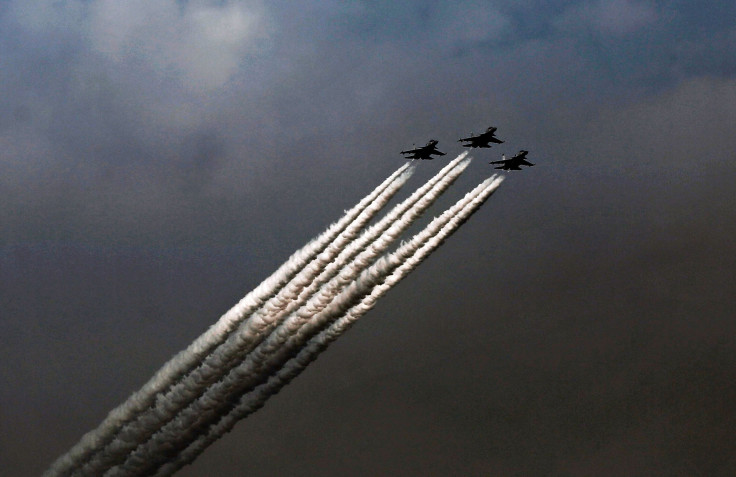India, Amid Negotiations For Multi-Billion Dollar Fighter Jet Deal, Becomes Top Global Arms Importer

India was the world’s largest importer of arms between the years 2010 and 2014, according to data released Monday by the Stockholm International Peace Research Institute (SIPRI).
The data also show that arms imported by the South Asian nuclear-armed economic powerhouse accounted for 15 percent of all global arms imports in this period. That figure is more than double the amount imported by the country in the 2005-2009 period. In the last five years, India was far ahead of the next big importer, Saudi Arabia, which accounted for 5 percent of the total global arms market and, by some estimates, is set to surpass India in 2015.
“Between 2005–2009 and 2010–14 imports increased by 140 per cent. In 2010–14 India’s imports were three times larger than those of either of its regional rivals China and Pakistan. This contrasts with 2005–2009 when India’s imports were 23 per cent below China’s and just over double those of Pakistan,” the SIPRI report notes. “India has so far failed to produce competitive indigenous-designed weapons and remains dependent on imports,” it adds.
The new findings, from the Sweden-based think tank, come as India negotiates a multi-billion dollar deal to procure fighter jets for its air force. It was in 2001 that the Indian Air Force (IAF) expressed a desire to acquire 126 new combat jets to replenish its dwindling and aging fleet of mostly Russian-made warplanes. And six major defense companies -- Lockheed Martin Corporation and Boeing Co. from the U.S.; Dassault Aviation, EADS and Saab AB from Europe; and Russia's RSK MiG, were in the fray for a deal that could eventually be worth over $20 billion. While Lockheed Martin and Boeing showcased the F-16 Super Viper and the F-18 Super Hornet, EADS had brought its Eurofighter Typhoon for the trials. Saab put its faith in its flagship plane, the JAS 39 Gripen, while Russia chose to push the Mikoyan MiG 35.
Last month, when French defense minister Jean Yves Le Drian met his Indian counterpart Manohar Parrikar in New Delhi, speculation was rife over when India may seal the deal with French defense major Dassault Aviation to buy between 126 and 200 medium multi-role combat aircraft for the IAF. India, which already owns Dassault-made Mirage 2000 fighter jets, has been negotiating with Dassault since January 2012, when it announced that the manufacturer of the Rafale fighter jet had the lower of two bids among companies shortlisted for passing technical qualifications. European Aeronautic Defense and Space Co (EADS), a multinational consortium, was the other bidder to clear the technical trial stage.
At present, India's air force, the fourth largest in the world and arguably the second most powerful in the region after China, depends heavily on inventory of Russian origin. And, even as India negotiates with the French, the IAF is in the process of inducting 272 Sukhoi fighter jets. Further, along with Russia, it is jointly developing a fifth-generation fighter aircraft with stealth capabilities.
But, though the IAF has a minimum sanctioned squadron strength of 39.5 with each squadron consisting of 20-22 fighter aircraft, it is reportedly actually operating at a fleet size of about 33 squadrons. And the IAF's strength has been depleted primarily because aircraft of older vintage have been phased out and also due to the rising number of crashes over the last decade, which have killed many highly-trained pilots.
In November last year, it was reported that India had become the world’s largest arms importer and is expected to spend more than $130 billion to bolster its armed forces over the next seven years. Although much of India’s military hardware continues to be of Russian origin, the U.S. has surpassed Russia as its biggest supplier. According to SIPRI, Russia supplied 70 percent of India’s arms imports in the last five years while the U.S. accounted for 12 percent and Israel 7 percent.
“The acquisitions from the USA are a break with the recent past,” the report notes. “Prior to 2005–2009 India barely received any major weapons from the USA. However, there now appears to be an upward trend in arms imports from the USA. Imports in 2010–14 were 15 times higher than in 2005–2009 and included advanced weapons such as anti-submarine warfare aircraft. In 2014 additional deals with the USA were agreed, including for 22 combat helicopters.”
Meanwhile, as India continues to negotiate terms for fighter jets, Saudi Arabia is set to surpass India as the world’s largest arms importer in 2015, according to data from research firm IHS.
© Copyright IBTimes 2024. All rights reserved.





















